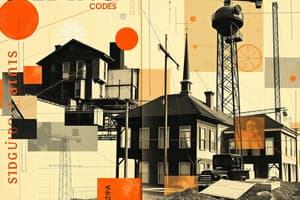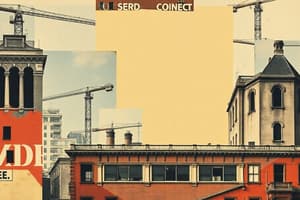Podcast
Questions and Answers
According to the NBCP, which construction type allows structural elements to be made of any material permitted by the code?
According to the NBCP, which construction type allows structural elements to be made of any material permitted by the code?
- Type V - Fire Resistive
- Type I - Wood-Framed (correct)
- Type III - Ordinary
- Type IV - Non-Combustible
Which construction type mandates that exterior walls be of incombustible fire-resistive construction?
Which construction type mandates that exterior walls be of incombustible fire-resistive construction?
- Type V - Fire Resistive
- Type II - Heavy Timber
- Type I - Wood-Framed
- Type III - Ordinary (correct)
In a Type II Heavy Timber construction, what fire-resistance duration is generally required throughout the structure?
In a Type II Heavy Timber construction, what fire-resistance duration is generally required throughout the structure?
- Two-hour fire resistive
- One-hour fire resistive (correct)
- Non-rated
- Four-hour fire resistive
Which type of construction primarily consists of steel, iron, concrete, or masonry, and must have a four-hour fire-resistive rating?
Which type of construction primarily consists of steel, iron, concrete, or masonry, and must have a four-hour fire-resistive rating?
For Type IV Non-Combustible construction, what material restriction applies to walls, ceilings, and permanent partitions?
For Type IV Non-Combustible construction, what material restriction applies to walls, ceilings, and permanent partitions?
What is a key distinction between concrete and masonry in construction?
What is a key distinction between concrete and masonry in construction?
What differentiates steel from iron as a construction material?
What differentiates steel from iron as a construction material?
According to fire-resistive requirements for different construction types, what is the required fire-resistive rating for exterior bearing walls of a Type V Fire Resistive building?
According to fire-resistive requirements for different construction types, what is the required fire-resistive rating for exterior bearing walls of a Type V Fire Resistive building?
What is the fire-resistive rating requirement for structural frames in Type IV Non-Combustible construction?
What is the fire-resistive rating requirement for structural frames in Type IV Non-Combustible construction?
What is the fire-resistive rating requirement for exterior doors and windows in all types of construction?
What is the fire-resistive rating requirement for exterior doors and windows in all types of construction?
According to standards for interior wall and ceiling finishes, what is the maximum allowable smoke density for finishes?
According to standards for interior wall and ceiling finishes, what is the maximum allowable smoke density for finishes?
What is the maximum flame-spread allowed for materials required to be flame-spread proofed, as determined by the 'Tunnel Test'?
What is the maximum flame-spread allowed for materials required to be flame-spread proofed, as determined by the 'Tunnel Test'?
Which test is used to assess the surface burning behavior of building materials, specifically measuring flame spread and smoke density?
Which test is used to assess the surface burning behavior of building materials, specifically measuring flame spread and smoke density?
In Type II Heavy Timber construction, under what condition can fire-retardant treated wood be used for permanent non-bearing partitions?
In Type II Heavy Timber construction, under what condition can fire-retardant treated wood be used for permanent non-bearing partitions?
If a building uses masonry and wood construction and is one-hour fire-resistive throughout, which type of construction does it likely belong to?
If a building uses masonry and wood construction and is one-hour fire-resistive throughout, which type of construction does it likely belong to?
How do the fire-resistive requirements for interior bearing walls differ between Type IV Non-Combustible and Type V Fire Resistive construction?
How do the fire-resistive requirements for interior bearing walls differ between Type IV Non-Combustible and Type V Fire Resistive construction?
What criteria must the products of combustion from interior wall and ceiling finishes meet?
What criteria must the products of combustion from interior wall and ceiling finishes meet?
In the context of fire-resistance, what distinguishes the requirements for Type II and Type III constructions regarding exterior walls?
In the context of fire-resistance, what distinguishes the requirements for Type II and Type III constructions regarding exterior walls?
Which of the following material characteristics does the Tunnel Test specifically evaluate?
Which of the following material characteristics does the Tunnel Test specifically evaluate?
For materials less than 1.00 millimeter in thickness cemented to wall or ceiling surfaces, what requirement regarding flame-spread characteristics applies?
For materials less than 1.00 millimeter in thickness cemented to wall or ceiling surfaces, what requirement regarding flame-spread characteristics applies?
Flashcards
Type I Construction
Type I Construction
Type I construction uses wood for structural elements, with material choices adhering to code standards.
Type II Construction (Heavy Timber)
Type II Construction (Heavy Timber)
Type II construction uses wood with fire-resistant materials, offering one-hour fire resistance.
Type III Construction (Ordinary)
Type III Construction (Ordinary)
Type III construction uses masonry and wood, requires one-hour fire-resistance, and incombustible exterior walls.
Type IV Construction (Non-Combustible)
Type IV Construction (Non-Combustible)
Signup and view all the flashcards
Type V Construction (Fire Resistive)
Type V Construction (Fire Resistive)
Signup and view all the flashcards
Concrete
Concrete
Signup and view all the flashcards
Masonry
Masonry
Signup and view all the flashcards
Iron
Iron
Signup and view all the flashcards
Steel
Steel
Signup and view all the flashcards
Type II and III Fire Rating
Type II and III Fire Rating
Signup and view all the flashcards
Type IV and V Fire Rating
Type IV and V Fire Rating
Signup and view all the flashcards
Tunnel Test (ASTM E84)
Tunnel Test (ASTM E84)
Signup and view all the flashcards
Study Notes
- Building Systems & Design - Week 11 - 2nd Semester 2025
Types of construction as per NBCP Section 401
- Buildings must be classified according to type in accordance with the Code and its Implementing Rules and Regulations (IRR).
Type I: Wood-Framed Construction
- Primarily wood construction utilizing any materials allowed by the Code for structural elements.
Type II: Heavy Timber Construction
- Wood composition that includes fire-resistant materials and one-hour fire resistance throughout.
- Fire-retardant treated wood may be used for permanent non-bearing partitions within the framing assembly that has one-hour resistivity.
Type III: Ordinary Construction
- Made of masonry and wood, with structural elements using code-permitted materials.
- Must have one-hour fire-resistance throughout and exterior walls of incombustible, fire-resistive construction.
Type IV: Non-Combustible Construction
- Features steel, iron, concrete, or masonry with incombustible fire-resistive walls, ceilings, and permanent partitions.
- One-hour fire-resistive construction may use fire-retardant treated wood for non-bearing partitions within the framing assembly.
Type V: Fire Resistive Construction
- Must have four-hour fire-resistive properties throughout.
- Structural elements consist of steel, iron, concrete, or masonry.
Concrete vs. Masonry
- Concrete is a composite of cement, sand, aggregate, and water that hardens into a durable substance.
- Masonry involves construction with brick, stone, or similar materials, bound by mortar.
- Poured concrete, reinforced or not, can be classified as masonry.
Iron vs. Steel
- Iron is a strong, hard, magnetic, silvery-gray chemical element used in construction and manufacturing, especially as steel.
- Steel is Iron and carbon alloy celebrated for its strength, durability for use in construction, manufacturing, and other applications.
Fire Resistive Requirements
- Exterior bearing and non-bearing walls must have a one-hour fire-resistive rating for Types II and III, and four hours for Types IV and V.
- Interior bearing walls, permanent partitions, floors, and roofs must have one-hour fire-resistive rating for Types II, III, and IV, with three hours for bearing walls for Type V.
- Structural frames have a one-hour fire-resistive rating for Types II and III, two hours for Type IV, and three hours for Type V.
- Exterior doors and windows must have a one-hour fire-resistive rating for all types.
Interior Wall and Ceiling Finishes
- Finishes must be classified by flame-spread characteristic of generally accepted engineering standards.
- Smoke density should not exceed that of burning untreated wood under similar conditions.
- Combustion products should be no more toxic than burning untreated wood.
- These finishes include interior wainscoting, paneling, decoration, acoustical correction, frames and trims of doors/windows, and surface insulation.
- Requirements do not apply to frames, trims of doors/windows, and materials less than 1.00 mm thick.
- Materials that require flame-spread proofing must be treated with a flame-retardant with a flame-spread of 50 or less per the "Tunnel Test".
Material Standards
- Use in structural frameworks, exterior walls, openings, floors, exits, stairs, and roofs must comply with the Fire Code of the Philippines provisions.
Tunnel Test (ASTM E84)
- Used to assess the surface burning behavior of building materials by measuring flame spread and smoke density.
Studying That Suits You
Use AI to generate personalized quizzes and flashcards to suit your learning preferences.



